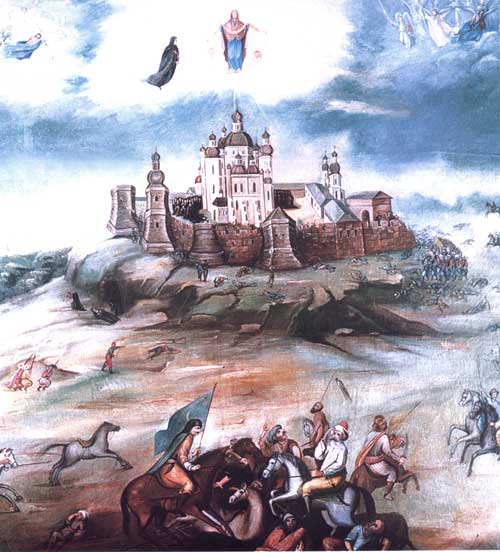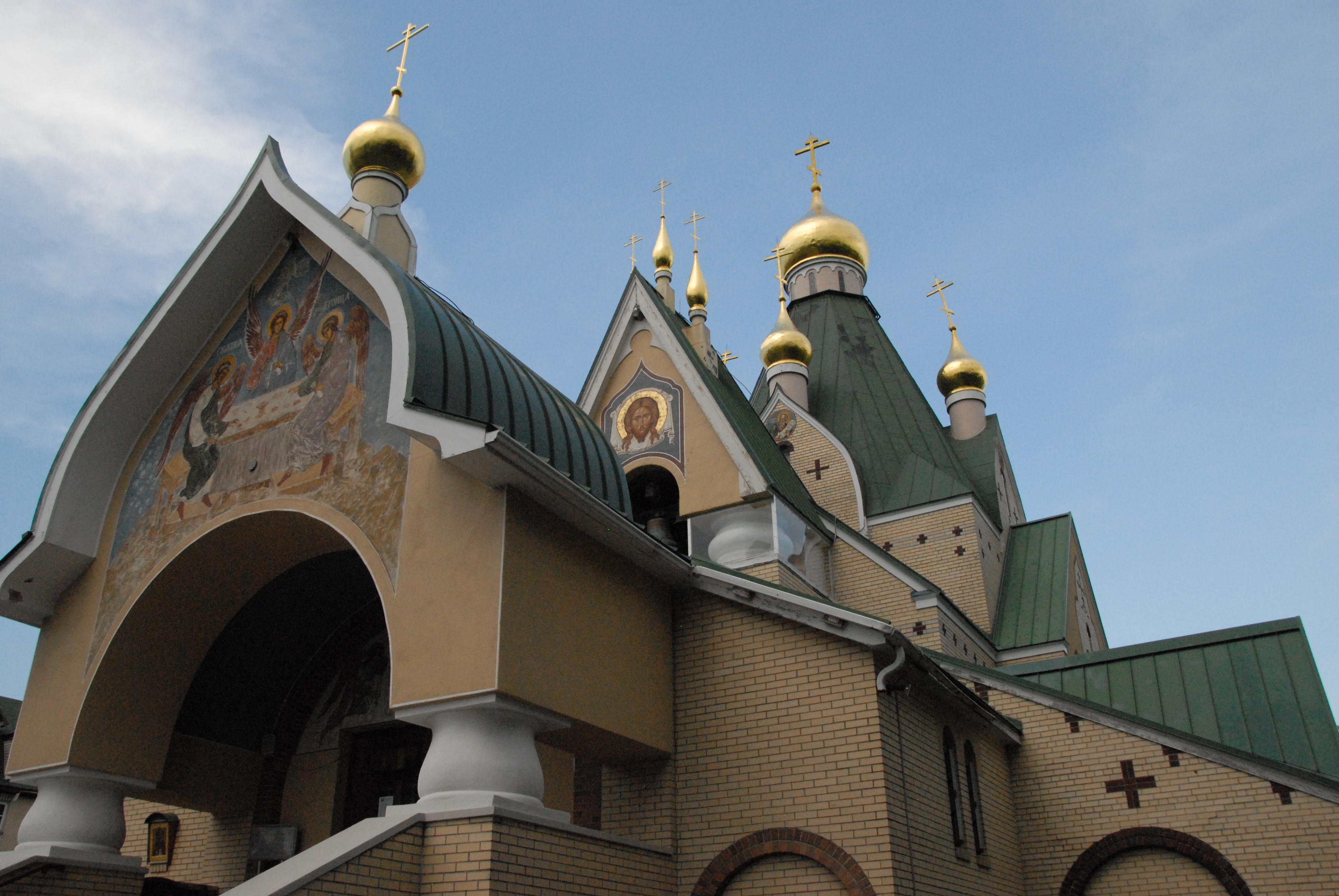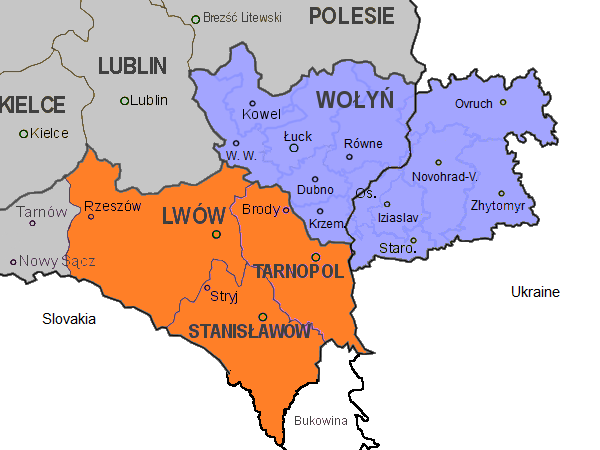|
Pochayiv Monastery
__NOTOC__ The Holy Dormition Pochaiv Lavra (, , ), also sometimes known as the Pochaiv Monastery, is a monastery and lavra in Pochaiv, Kremenets Raion, Ternopil Oblast, Ukraine. The monastery tops a 60-metre hill in the town of Pochaiv, 18 km southwest of Kremenets and 70 km north of Ternopil. The Pochaiv Lavra has been an important spiritual and ideological centre of Eastern Orthodoxy until 1720, then of Greek Catholicism until 1831, after which it returned into the Russian Orthodox fold. In December 2023, after years of disputes, a ruling by the Supreme Court of Ukraine deprived the Ukrainian Orthodox Church (Moscow Patriarchate) of its prior control of the monastery. History Origins A first record of the monastery in Pochaiv dates back to 1527, although a local tradition claims that it was established three centuries earlier, during the Mongol invasion, by several runaway monks, either from the Kyiv Monastery of the Caves or from the Holy Mount Athos. The legen ... [...More Info...] [...Related Items...] OR: [Wikipedia] [Google] [Baidu] |
Pochaiv
Pochaiv (, ; ; ; ) is a city in Kremenets Raion, Ternopil Oblast, western Ukraine. It is located south-west of Kremenets and north of the administrative center of the oblast, Ternopil. It hosts the administration of Pochaiv urban hromada. Population: History Pochaiv was a part of Kremenetsky Uyezd, Volhynian Governorate, Russian Empire. During World War I, it was captured by the Austro-Hungarian Army in August 1915 and by the Imperial Russian Army during the Brusilov offensive in summer 1916. It became a part of Wołyń Voivodeship, Poland, after the 1917 Russian Revolution and the Polish–Soviet War. Pochaiv became an urban-type settlement in the 1950s and a town in 1978. It had a population of 10,019 in January 1989.Почаев // Большой энциклопедический словарь (в 2-х тт.). / редколл., гл. ред. А. М. Прохоров. том 2. М., "Советская энциклопедия", 1991. стр.190 Pochaiv is home to t ... [...More Info...] [...Related Items...] OR: [Wikipedia] [Google] [Baidu] |
Sledovik
Sledovik (Следовик, in Russian literally – a Footprint Stone) is a most widespread type of sacred stones, venerated in Slavic (Russian, Belarusian, Ukrainian) and Finnic (Karelia, Merya people, Merya) paganism, pagan practices. These are big stones, usually granite boulders of glacier origin, with hollows in them, that frequently bear traces of processing (seem to be artificially deepened and/or widened), and in some cases resemble foot traces, similar to those that might be left by a bare foot on a soft clay-like surface (hence the name). It is not completely clear if the stones were selected for veneration because the hollows resembled foot traces, or whether the hollows were processed to resemble footprints; most probably both interpretations are at least partly applicable. Sometimes it is hard to draw a line between the Sledovik stone and the so-called Chashechnik stone (Чашечник, literally – a cup-stone), as the only difference between these two is that ... [...More Info...] [...Related Items...] OR: [Wikipedia] [Google] [Baidu] |
Jordanville, New York
Jordanville is a hamlet in the town of Warren, Herkimer County, New York, United States. Jordanville is in the northwestern part of Warren, at the intersection of New York State Route 167 and County Route 155. The community was settled by European Americans after the Revolutionary War and before 1791. Its name was derived from the nearby Ocquionis Creek, which was used by settlers for baptisms and likened by them to the Jordan River. History The hamlet was once served by the Southern New York Railroad, an electric trolley line that ran from Oneonta to Mohawk. Gelston Castle This castle was built in 1836 by Harriet Douglas Cruger, with stone sourced from Little Falls, New York. She had been inspired as a young woman by seeing Gelston Castle, owned by her uncle in Scotland, which she visited. Harriet Douglas was described as an independent and eccentric woman, who had her marriage bed sawed in half and used as two couches after an acrimonious divorce. She was profile ... [...More Info...] [...Related Items...] OR: [Wikipedia] [Google] [Baidu] |
Ruthenians
A ''Ruthenian'' and ''Ruthene'' are exonyms of Latin language, Latin origin, formerly used in Eastern and Central Europe as common Ethnonym, ethnonyms for East Slavs, particularly during the late medieval and early modern periods. The Latin term was used in medieval sources to describe all Eastern Slavs of the Grand Duchy of Lithuania, as an exonym for people of the former Kievan Rus, Rus, thus including ancestors of the modern Belarusians, Rusyns and Ukrainians. The use of ''Ruthenian'' and related exonyms continued through the early modern period, developing several distinctive meanings, both in terms of their regional scopes and additional religious connotations (such as affiliation with the Ruthenian Greek Catholic Church). In medieval sources, the Latin term was commonly applied to East Slavs in general, thus encompassing all endonyms and their various forms (; ). By opting for the use of exonymic terms, authors who wrote in Latin were relieved from the need to be specific ... [...More Info...] [...Related Items...] OR: [Wikipedia] [Google] [Baidu] |
Volhynia
Volhynia or Volynia ( ; see #Names and etymology, below) is a historic region in Central and Eastern Europe, between southeastern Poland, southwestern Belarus, and northwestern Ukraine. The borders of the region are not clearly defined, but in Ukraine it is roughly equivalent to Volyn Oblast, Volyn and Rivne Oblasts; the territory that still carries the name is Volyn Oblast. Volhynia has changed hands numerous times throughout history and been divided among competing powers. For centuries it was part of the Polish-Lithuanian Commonwealth. After the Russian annexation during the Partitions of Poland, all of Volhynia was made part of the Pale of Settlement on the southwestern border of the Russian Empire. Important cities include Rivne, Lutsk, Zviahel, and Volodymyr (city), Volodymyr. Names and etymology *, ; * ; *, ; * or ; *; * ; *; *; * or (both ); Volhynian German: , , or (all ); *, or . The alternative name for the region is Lodomeria after the city of Volodymyr (city ... [...More Info...] [...Related Items...] OR: [Wikipedia] [Google] [Baidu] |
Galicia (Central Europe)
Galicia may refer to: Geographic regions * Galicia (Spain), a region and autonomous community of northwestern Spain ** Gallaecia, a Roman province ** The post-Roman Kingdom of the Suebi, also called the Kingdom of Gallaecia ** The medieval Kingdom of Galicia ** The Republic of Galicia, which only lasted for a few hours on 27 June 1931 * Galicia (Eastern Europe), a historical region in southeastern Poland and western Ukraine ** The Kingdom of Galicia–Volhynia or Kingdom of Rus, a medieval kingdom ** The Kingdom of Galicia and Lodomeria, a crown land of the Austrian Empire and later the Austrian half (Cisleithania) of Austria-Hungary ** West Galicia or New Galicia, a short-lived administrative region of the Austrian Empire, eventually merged into the Kingdom of Galicia and Lodomeria ** The District of Galicia, part of the Nazi General Government during the World War II occupation of Poland Named after Spanish Galicia * Galicia, Aklan, a barangay in Panay, Philippines * Nuev ... [...More Info...] [...Related Items...] OR: [Wikipedia] [Google] [Baidu] |
Ostrogski
The House of Ostrogski (; ; ) was one of the more prominent families in the Crown of the Kingdom of Poland, Kingdom of Poland, the Grand Duchy of Lithuania and in the Polish–Lithuanian Commonwealth. The family spanned from the 14th century Ruthenia, Ruthenian noble Daniil Ostrogski to the 17th century Polish members. After the death of Janusz Ostrogski, the last male heir, most of the family's possessions passed to the Zasławski family. The family played a crucial role in preserving the Eastern Orthodoxy, particularly during the Union of Brest signing in 1595. Members contributed to printing books in Church Slavonic (Kyiv [Ruthenian] recession) and supporting the Orthodox brotherhoods. By the 17th century almost all members turn to Catholicism and became fully associated with the Polish nation (Polonization). Many of their possessions were passed on or inherited by members of Sanguszko family. History The Ostrogski family was most likely of Rurikid stock and descended from S ... [...More Info...] [...Related Items...] OR: [Wikipedia] [Google] [Baidu] |
Union Of Brest
The Union of Brest took place in 1595–1596 and represented an agreement by Eastern Orthodox Churches in the Ruthenian portions of the Polish–Lithuanian Commonwealth to accept the Pope's authority while maintaining Eastern Orthodox liturgical practices, leading to the formation of the Ruthenian Uniate Church, which currently exists as the Ukrainian Greek Catholic Church and the Belarusian Greek Catholic Church. The union Background Rome-oriented Christians and their Byzantium-oriented counterparts formally severed connections from 1054. Subsequent attempts to unify Eastern Orthodox believers and the Catholic Churches were made on several occasions, including an instance in 1452 in which the deposed Metropolitan of Kiev, Isidore (in office from 1437 to 1441), endorsed the 1439 Union of Florence and formally promised the unity of the Ruthenian Orthodox Church with Rome. In 1588–1589, Patriarch of Constantinople Jeremias II traveled across Eastern Europe, particul ... [...More Info...] [...Related Items...] OR: [Wikipedia] [Google] [Baidu] |
Russian Orthodox Church
The Russian Orthodox Church (ROC; ;), also officially known as the Moscow Patriarchate (), is an autocephaly, autocephalous Eastern Orthodox Church, Eastern Orthodox Christian church. It has 194 dioceses inside Russia. The Primate (bishop), primate of the ROC is the patriarch of Moscow and all Rus'. The History of the Russian Orthodox Church, history of the ROC begins with the Christianization of Kievan Rus', which commenced in 988 with the baptism of Vladimir the Great and his subjects by the clergy of the Ecumenical Patriarch of Constantinople, ecumenical patriarch of Constantinople. Starting in the 14th century, Moscow served as the primary residence of the Russian List of metropolitans and patriarchs of Moscow, metropolitan. The ROC declared autocephaly in 1448 when it elected its own metropolitan. In 1589, the metropolitan was elevated to the position of patriarch with the consent of Constantinople. In the mid-17th century, a series of reforms led to Schism of the Russian ... [...More Info...] [...Related Items...] OR: [Wikipedia] [Google] [Baidu] |
Bulgaria
Bulgaria, officially the Republic of Bulgaria, is a country in Southeast Europe. It is situated on the eastern portion of the Balkans directly south of the Danube river and west of the Black Sea. Bulgaria is bordered by Greece and Turkey to the south, Serbia and North Macedonia to the west, and Romania to the north. It covers a territory of and is the tenth largest within the European Union and the List of European countries by area, sixteenth-largest country in Europe by area. Sofia is the nation's capital and List of cities and towns in Bulgaria, largest city; other major cities include Burgas, Plovdiv, and Varna, Bulgaria, Varna. One of the earliest societies in the lands of modern-day Bulgaria was the Karanovo culture (6,500 BC). In the 6th to 3rd century BC, the region was a battleground for ancient Thracians, Persians, Celts and Ancient Macedonians, Macedonians; stability came when the Roman Empire conquered the region in AD 45. After the Roman state splintered, trib ... [...More Info...] [...Related Items...] OR: [Wikipedia] [Google] [Baidu] |
Theotokos Of Pochayiv
''Theotokos of Pochayiv'' () is an Eastern Orthodox icon of the Virgin Mary, painted in a late Byzantine style, of the Eleusa iconographic type. Like many famous icons, it is now usually displayed with most of the surface covered by an elaborate frame in precious metals, or riza, except for the faces. The icon is venerated equally by Eastern Orthodox and Catholics. The origin of the icon is not clear. It is painted in old Byzantine manner, hence it could be made in either Byzantium or Bulgaria. Icon description The icon belongs to the Eleusa type. The Mother of God is depicted with baby Jesus, who is leaning against her face. The icon also shows a rock. According to legend, there is a footprint of the Virgin Mary on this rock. History of the icon It has been in the Pochaiv Lavra (monastery), in Ternopil oblast, Ukraine, since 1597, when it was given by a wealthy widow Anna or Hanna Hoyska, who owned the town of Pochaiv in the second half of the 16th century. Anna had ... [...More Info...] [...Related Items...] OR: [Wikipedia] [Google] [Baidu] |
Icon
An icon () is a religious work of art, most commonly a painting, in the cultures of the Eastern Orthodox, Oriental Orthodox, Catholic Church, Catholic, and Lutheranism, Lutheran churches. The most common subjects include Jesus, Mary, mother of Jesus, Mary, saints, and angels. Although especially associated with portrait-style images concentrating on one or two main figures, the term also covers most of the religious images in a variety of artistic media produced by Eastern Christianity, including narrative scenes, usually from the Bible or the lives of saints. Icons are most commonly painted on wood panels with egg tempera, but they may also be cast in metal or carved in stone or embroidered on cloth or done in mosaic or fresco work or printed on paper or metal, etc. Comparable images from Western Christianity may be classified as "icons", although "iconic" may also be used to describe the static style of a devotional image. In the Greek language, the term for icon painting uses ... [...More Info...] [...Related Items...] OR: [Wikipedia] [Google] [Baidu] |






